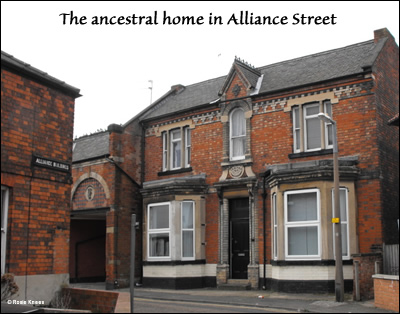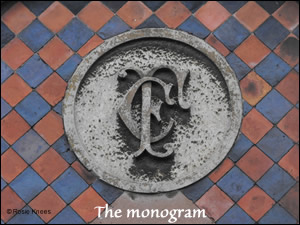Frederick William Cox became the owner of the ‘Blue Man Inn’ in Newark in about August 1873, as recorded in the Register of Licenses (Pursuant to The Licensing Act 1872) at the Nottingham Archives.
Although not the owner, Frederick was already the licensee of the ‘Coach and Horses’ in Middlegate and continued to be so until after the census of 1881. The Register of Licenses recorded the new licensee, Henry Bailey, on 7 April 1881.

I’m not sure when Frederick took over the running of the ‘Coach and Horses’, but in 1869, when he was just 30 years old, he was listed in a trade directory as a ‘Licensed Victualler and Cattle Dealer’. He lived there for the next 12 years, along with his wife Sarah Eliza (nee Pick) and their children Betsy, William, Thomas, Mary and Frederick. Sadly, Thomas died in December 1872, aged 9 years, as did two more children, Henry in April 1878 at 5 months and Charles Frederick in April 1879 aged just 3 months. I only know about these two babies, who were born and died between the censuses, from their inscription on Frederick and Sarah’s monument in the cemetery.
Frederick owned the ‘Blue Man’ until his death on 26th October 1887. After that date the Register of Licensees states in the ‘owner’ column “the trustees of the will of Frederick William Cox, deceased”. As far as I can tell, Frederick never actually lived at the ‘Blue Man’ as he is listed in the census records for 1881 as the licencee at the ‘Coach and Horses’, and in later trade directories as living at 51 Alliance Street (a house he had built himself which bears his monogram). His son William was running the ‘Blue Man’ in 1883, more of which later.
The licensing trade was well established in the Cox family for at least three generations. Frederick’s father William Cox and mother Mary (nee Green) ran a beerhouse called ‘The Great Northern Tavern’ at 40 Lincoln Road, Newark, for around 25 years. A beerhouse was not the same as a pub, as it was only licenced to sell beer and cider, not wines and spirits. It was also only open six days a week (Monday to Saturday). In the 19th century gin was a very popular drink and beerhouses were opened to try to cut down on alcohol consumption. ‘The Great Northern Tavern’ was opened as an un-named beerhouse during the 19th century and given the name in 1853, probably after the establishment of the Great Northern Railway Line in 1852. It was renamed ‘The Walnut Tree’ around the end of 1920, after the Coxes had long gone. The name ‘The Lincolnshire Poacher’ is also mentioned in its history.

The first record I have of William and Mary running ‘The Great Northern Tavern’ (which was owned by John Chappel of Norwell Woodhouse) is the 1861 census. The Register of Licenses doesn’t begin until 1872, so I don’t know what the Coxes got up to in their first 11 years of tenancy. However on 30th November 1873, “the house was open on a Sunday during prohibited hours” , and William was subsequently fined 20 shillings, with costs of 10 shillings and had his licence endorsed. He was at it again on Sunday 12th April 1874 and this time was fined 20 shillings with 12 shillings costs, and again his licence was endorsed.
William died in 1882 and Mary took over the licence. She, too, blotted her copybook. It states in the Licensing Register for June 1885, “having house open during prohibited hours, viz at 11.30 of the clock in the morning of Sunday 7th inst. Fine 40 shillings and 22 shillings costs. Licence endorsed”. Quite an increase in the charges over 11 years!

I hope to go to the archives sometime and look at the quarter/petty sessions and see if I can find out a bit more about these wayward incidents. Maybe I will be able to find out whether some kind soul reported them to the authorities.
The irony is that the tavern was established because of the railway, but in 1936 it was closed and demolished to make way for the A46 road bridge over the railway, where a simple road crossing used to be. A single walnut tree still stands on the bank of the road bridge; it is not known whether the tree was planted ‘in memoriam’ to the beerhouse or whether it was in its grounds.
The next generation of publicans was William and Mary’s grandson (and Frederick’s son), William. As previously mentioned he ran the ‘Blue Man’. Family Tree Forum member, Merry Monty Montgomery, discovered that it was reported in the Hull Packet and East Riding Times on Friday 16th November 1883, that William was fined for moving cattle into the Gainsborough district without a licence. The fine was £1 per head (12 cows) and £1 10s 4d costs. £12 must have been an awful lot of money which reflects the seriousness of the offence during an outbreak of foot-and-mouth disease. The DEFRA website shows that there were outbreaks of the disease between 1877 and 1887. 1883 was a very serious year with more than a quarter of a million animals infected or slaughtered, and the greater part of 18,000 outbreaks over 75 counties
Two of the pubs that the Cox family ran, the ‘Coach and Horses’ and the ‘Great Northern Tavern’, have been gone for many years. However, the ‘Blue Man has recently been closed down and sold. A subsequent planning application to the local authority has a historical report which states that the pub was sold to a local brewery in 1901 – which was the year Frederick’s widow, Sarah, died.
There are many loose ends in this story; where did Frederick get the money to buy the ‘Blue Man’? What was the family link between beerhouse keeper and cattle dealer? Why did William and Mary persist in opening on a Sunday? All things I look forward to following up in the future.
Rosie Knees
© Rosie Knees 2009
Sources and Further Reading
Parish registers and Register of Licenses at Nottinghamshire Archives.
Defra (the Department for Environment, Food and Rural Affairs)
“Newark Inns and Public Houses” by Rodney Cousins